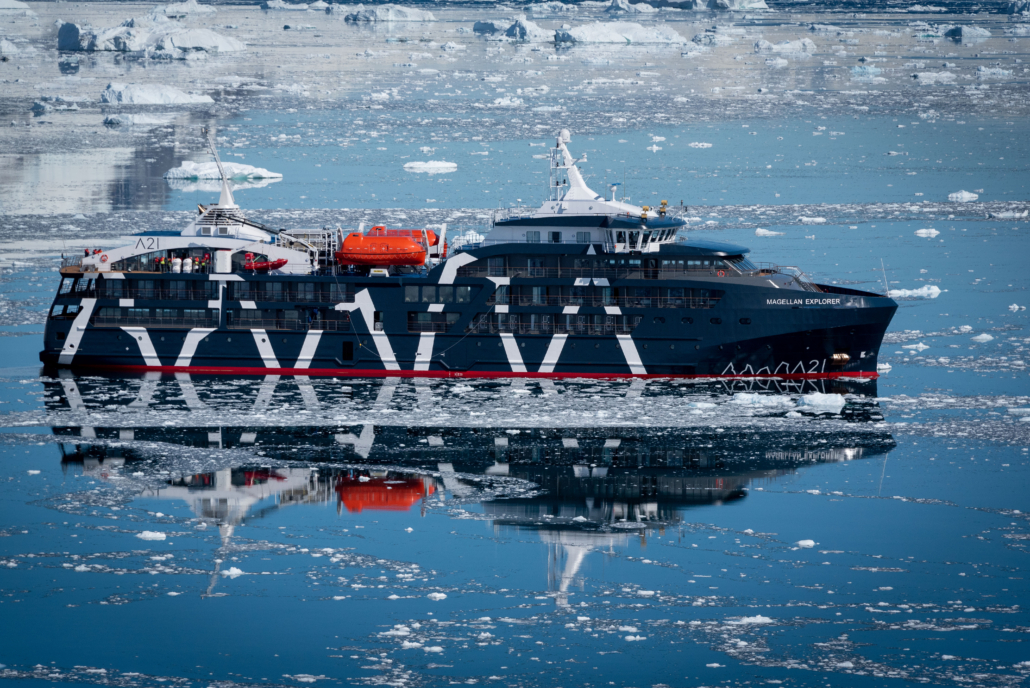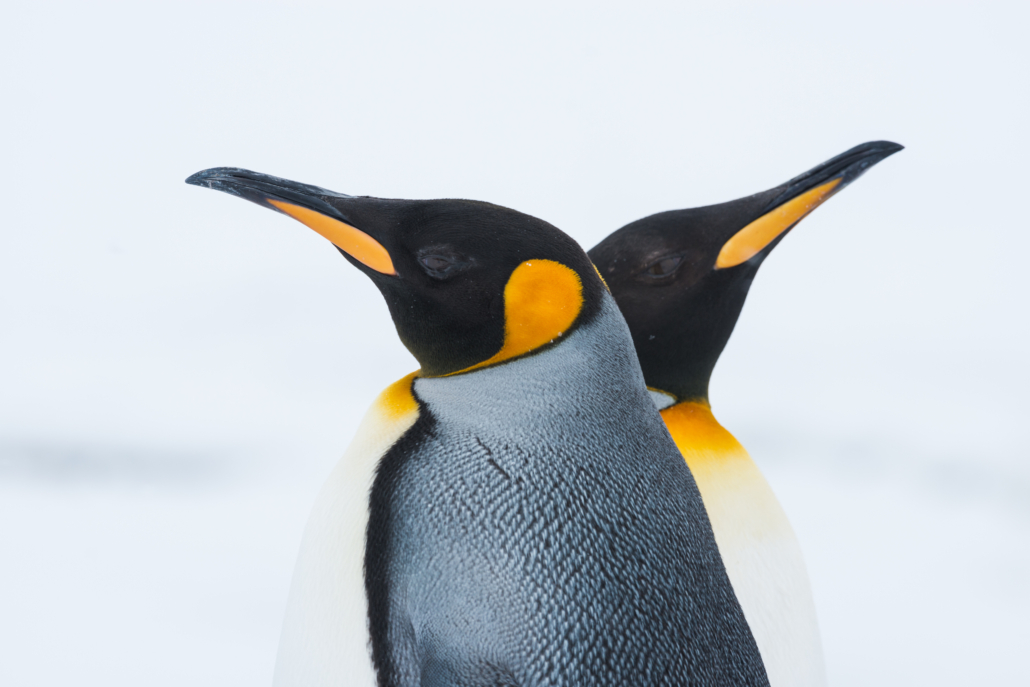Why go to South Georgia?
Guided by respected voyage operator Antarctica21, successful applicants for our Inspiring Explorers Expedition™ South Georgia will cruise in inflatable Zodiac boats, visiting vast king penguin rookeries, seal covered beaches, and many important historic sites connected to Shackleton, including his final resting place.
What does the expedition involve?
Antarctic Heritage Trust is offering a group of inspiring young New Zealanders the chance to join the ship-based Inspiring Explorers Expedition™ South Georgia 2023 as part of the Shackleton Centenary Year Expedition between 28 September–17 October 2023. A two-day expedition to climb Mount Worsley will also be completed by three Inspiring Explorers™ with Trust Emeritus Executive Director, Nigel Watson, and qualified guides.
When is the expedition and for how long?
The expedition will take place between 30 September–14 October 2023 (embarkation and disembarkation in Port Stanley, Falkland Islands) with travel from New Zealand to the Falkland Islands taking place before these dates and return travel from the Falkland Islands to New Zealand after these dates (28 September – 17 October 2023). Travel includes a stopover night each way in Punta Arenes, Chile. Prior to the expedition, there will be a team building weekend in Auckland in June that the Inspiring Explorers™ will need to be able to attend.
Where is South Georgia and what’s it like?
South Georgia is an island the South Atlantic Ocean that is part of the British Overseas Territory of South Georgia and the South Sandwich Islands. It lies around 3,000 kilometres east of the Argentinian coast (South America). Stretching in the East–West direction, South Georgia is around 170 kilometres long and has a maximum width of 35 kilometres. The terrain is mountainous, with the central ridge rising to 2,935 metres at its high peak, Mount Paget. The northern coast is indented with numerous bays and fjords, serving as good harbours. It is a cold and wild place, open to ocean swells as well as the other temperature and weather effects of having a cold ocean surrounding it. Undeniably beautiful, South Georgia is said to be one of the most spectacular places to visit on the planet. The South Georgia Heritage Trust works to preserve the island’s natural and historical heritage.
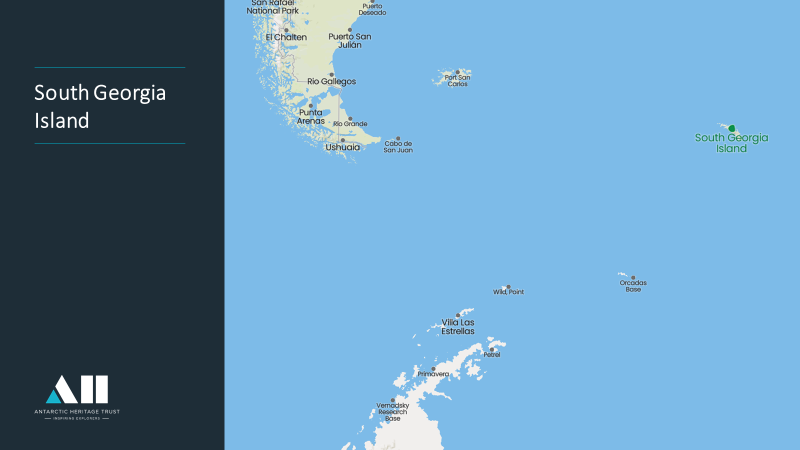
How long will it take to get to South Georgia and how do you get there?
From New Zealand, we will fly out of Auckland to Santiago (Chile), which will take around 11 hours (9674km). We will overnight in Santiago, then fly onto Punta Arenas (Southern Chile) on another flight for around 3.5 hours (2179km). From here one last flight will take us to Port Stanley (Mount Pleasant airport) in the Falkland Islands which will take around 1.5 hours (853km). There, the Antarctica21 ship crew will meet us and transport us to the Magellan Explorer (ship).
Sailing to and from the Falkland Islands to South Georgia will take between 2 to 3 days (1525km) depending on the weather and ocean conditions. Having spent 8 days exploring South Georgia Island, and landing in various places, the ship will return over 2-3 days to the Falkland Islands, then fly back to New Zealand through Punta Arenas and Santiago with overnight stops as required.
Note: The map below only shows the flight routes and not the sailing leg of the expedition. South Georgia is circled in red.

What and when is the Team Building Weekend?
Prior to the expedition, there will be a teambuilding weekend, likely to be based in Auckland, on June 17th/18th that the successful Inspiring Explorers™ will need to attend. The purpose of the weekend is to create a strong team, by forming bonds and connections, and enabling everyone to work towards a common goal. We will structure the weekend to involve practical activities, that will bring the Inspiring Explorers team together. Other key areas that will be discussed over the weekend will include Health and Safety, outreach and expectations.
What sort of Outreach do I need to participate in?
During the expedition we are looking at completing some projects working alongside our partners, Metservice and the Royal Society Te Apārangi. These projects will range in subjects, from climate change, to science, history, art and education. Projects can, and will be undertaken utilising a huge range of your skills and experience in small groups. The Trust’s communication team will work closely with the expedition team on your individual and your team’s outreach requirements.
Post trip we encourage all our Inspiring Explorers™ to share their stories within their communities through their dedicated outreach programme.
What is the connection to Antarctica?
The Antarctic Heritage Trust is planning to honour the centenary year of Shackleton’s final expedition (the Quest) which journeyed to South Georgia and marked the end of the heroic-era of Antarctic exploration. Shackleton sadly passed away on this trip and is buried on South Georgia. His expeditions are still some of the greatest feats in survival and leadership that come from the heroic age of exploration in Antarctica, and will forever link him and Antarctica to South Georgia Island. The Trust cares for Shackleton’s only Antarctic expedition base.
Application and selection
Who can apply for this expedition?
There is a number of criteria for applicants to meet to be eligible for this expedition. These include being aged between 18-30, and being a citizen or permanent resident of New Zealand. You will need a valid passport for this expedition.
Please read the full Eligibility Criteria and Expedition Member Obligations for all the requirements.
What are the limitations around age?
While our application age range is between 18 – 30, we appreciate there are some unique situations around this. If you are currently 17 but will be 18 at the time of the expedition you are welcome to apply. If you are currently 30 but will be 31 by the time of the expedition you are also welcome to apply. In both these cases, please contact us on inspiring@nzaht.org for further instructions. Unfortunately we can’t take any application from under 18’s and will not look to process applications from anyone over 30 at the time of application. However, if you are outside of these parameters but feel you have a significant reason to be considered, then please contact us and we will make decisions on a case by case basis.
What if I am a New Zealand citizen or permanent resident living overseas?
Applications from New Zealand citizens or permanent residents who intend to return to New Zealand must be able to show they have met, or are able to meet all immigration and health requirements.
Can I apply as an Australian citizen?
Under New Zealand Immigration law, Australian citizens and permanent residents can live and work in New Zealand. Those who are Australian Citizens/Residents and currently reside in New Zealand are more than welcome to apply for this expedition. If this applies to you please contact us on inspiring@nzaht.org for further instructions.
What is the application process?
Please check the Eligibility Criteria to ensure you qualify for the Inspiring Explorers Expedition™ South Georgia before applying. There a few stages to the application process in which applicants will be vetted and some will not be able to carry on.
The application process is outlined below:
- Register/create an account
- Part 1: Complete the online application form – written questions, contact information, referee details and declaration
- Part 2: Record and submit five video responses to interview questions (a link will be emailed to you to complete the video responses)
- Part 3: Live video interview with Antarctic Heritage Trust team
- Part 4: Antarctic Heritage Trust will advise successful applicants
Please contact us if you have any questions about the application process.
What is the selection process?
The Trust’s selection panel will review all applications and choose a shortlist of applicants to interview. Following interviews and reference checks the successful team will be advised. There will also be reserve spaces offered, in the event that a member of the team has to pull out.
Can I apply if I have a permanent disability?
Antarctic Heritage Trust welcomes applications from everyone and strives to be an inclusive and equitable organisation. However, this expedition will require a certain level of physical and mental ability in order to meet the health and safety requirements set out on board the ship and when on South Georgia Island. Please contact us on the details provided to discuss your unique situation as we will strive to make this opportunity as accessible as possible.
Can I change my application once it’s been submitted?
No. So please ensure you’ve planned exactly what you want to say and even had a practice before recording your video answers. You will be able to re-record your answers up to five times so practice beforehand. Please also be aware each video response has a set time limit. These time limits will be available for you to see to plan and practice your answer.
Can I bring or nominate a friend or partner to come with me?
We welcome you to share the expedition details with your friend or partner but please note everyone must apply through the same process. You are welcome to note/mention friends and partners within your application but no preference or discrimination will be given on this basis.
Can I use my mobile to record my video responses to the interview questions?
The application website is mobile compatible, so you should be able to complete your application on your phone, including your video responses.
Should you have issues with this please contact us.
What are the COVID-19 requirements?
Each Inspiring Explorer should be fully vaccinated for COVID-19*. Inspiring Explorers must comply with all Health & Safety regulations and requirements, including COVID-19; both from AHT and/or any third parties, such as Antarctica21 or airlines. Due to changing nature of the COVID-19 pandemic further advice will be issued closer to expedition.
* You are up to date with your COVID-19 vaccines when you have completed a COVID-19 vaccine primary series and got the most recent booster dose available in your country of residence. If you have completed your primary series—but are not yet eligible for any further boosters—you are also considered up to date. In New Zealand this is commonly considered two primary doses plus 1 booster dose.
What if I have a medical exemption from COVID-19 vaccinations?
Genuine medical exemptions will be treated the same as fully vaccinated applicants and will be taken on a case by case basis.
How fit do I need to be?
While you do not need to be an elite athlete to do this expedition, you will need to be in good health and have a reasonably good level of fitness, stamina and resilience to be able to undertake the on-island parts of the expedition. A positive attitude and being mentally prepared is also critical. Applications for the Mount Worsley climb must meet certain criteria.
Do I need any experience to apply?
No previous experience is necessary to apply for this expedition. We are seeking applicants with a sense of adventure who are willing to inspire their communities.
For those looking to apply to climb Mount Worsley mountaineering experience is essential and there will be specific questions on your climbing background and experience. Read more about Eligibility Criteria here.
What things will I be doing on South Georgia?
How do I apply to climb Mount Worsley?
As part of the initial application process you will be able to identify your interest in being selected for the Mt Worsley trip. You will then have additional questions asked around your mountaineering experience. Please see the additional requirements to be considered for this trip set out in the Eligibility Criteria and Expedition Member Obligations.
Is there further training for the Mount Worsley climb?
Absolutely! While dates are still to be confirmed, there will be anywhere between 1-4 additional training weekends for our Mount Worsley team. These will be through the New Zealand winter months and must be attended by chosen applicants. Costs will be covered for flights, food and accommodation for this. This training will be with our expert guides and cover movement in and around the alpine and sub-polar environment. It will also be a key time to build a strong team dynamic ready to take on Mount Worsley while in South Georgia. Further information will be provided to the successful applicants.
Will my application be shared with anyone else?
All applications are held securely through our application website adhering to the Privacy Act 2020. Information may be shared with our expedition partners in strict confidence as part of the selection process
How do I contact you about my application?
Should you have any further questions then please contact us on these details:
Mike Barber – Inspiring Explorers™ Programme Manager
Email – inspiring@nzaht.org
Phone – 021 268 4144
Cost
What if I can’t afford the expedition cost?
Should you find the cost of the expedition a limiting factor then please reach out to us on our contact information, we will do all we can to make this opportunity is available to anyone meeting the eligibility criteria and make decisions on a case by case basis.
How much will the expedition cost?
We ask each Inspiring Explorer™ to contribute NZD $2000 towards the expedition, with a payment of $1000 to be made immediately upon acceptance and the remaining balance payable by Friday 16 June 2023.
Antarctic Heritage Trust will pay for:
- All flights for the expedition
- All accommodation and incidentals directly before and after the expedition
- The expedition itself, including permits, guides, transport, food and group equipment costs
- Any travel required and accommodation for the training weekend in June
If selected for the expedition, you will need to cover the following costs:
- NZD $2000 towards the expedition
- Suitable travel insurance for the expedition
- Overweight/excess baggage fees (if required)
- Personal clothing and equipment
- Any visas required for the expeditions (permanent resident with non-NZ passports only, depending on passport nationality)
How much will the team building weekend cost?
Antarctic Heritage Trust will cover the cost of travel to and from the team building weekend likely to be in Auckland. Food and accommodation will also be provided for the training weekend so only additional personal purchases will cost the successful applicants.
Equipment
What specific gear do I need?
All participants will need to have their own clothing and equipment, or be willing to hire any gear they do not have.
A full gear list will be shared with successful candidates. You can expect this to include cold weather clothing, meaning warm layers, quality cold weather clothing and good wind/waterproofs.
Thermal rubber boots will be provided for you when making shore landing on South Georgia but you should still bring along warm and sturdy footwear.
Good UV protection is a must. Quality sunglasses and high factor sunscreen is also a must.
Taking a pair of binoculars is advised as it will be a great way to see more of the amazing wildlife up close.
A waterproof backpack or dry bag inside a day backpack is advised to carry your belongings during shore excursions.
How much will the gear cost?
Depending on how much gear you need the cost of buying equipment and/or hiring equipment will vary. When sending out gear lists we will aim to give you guidance on quality and locations for purchase as you don’t need to buy the most expensive equipment available to stay warm and dry. Specific climbing equipment for the Mount Worsley trip will be discussed with the successful applicants.
How much can I bring with me on the expedition?
Baggage will be limited to what the airline can carry. Usually this is around 22kg plus hand luggage, but this will be confirmed with the successful applicants.
Can I bring personal sponsorship on the expedition?
No. Due to the Trust’s own obligations to sponsors we require all successful applicants to come clean of any advertising sponsorship.
Can I bring my devices, phone, laptop, camera etc?
You’re welcome to bring any devices you choose but please ensure they are covered under your personal travel insurance as it will be your responsibility to look after them.
Can I bring a drone?
Generally, the expeditions run with Antarctica 21’s ships don’t allow the use of drones. Should this be something you are passionate about we can approach the ship about the possibility. If you were allowed a drone, please ensure it is covered under your personal travel insurance as it will be your responsibility. Use of the drone may be limited on board the ship and on South Georgia, permission and direction must be sought from ships and/or AHT staff and must be adhered to.
Ship
Will I have to share a room?
Yes. Our Inspiring Explorers Expedition™ will have two explorers to every cabin. The Trust will allocate cabins to the selected applicants.
What will I eat on the ship?
There are high quality chefs on board the Magellan Explorer who make a huge range of delicious food ensuring you’ll never go hungry. As well as three good meals a day there is always tea, coffee and other drinks available. This, as well as frequent morning and afternoon tea treats.
Do you cater for dietary requirements?
The on-board ships culinary team can cater for almost any dietary restriction except for Kosher and vegan. We will ask you about food allergies during the application process and check to ensure the ship can cater for your needs, which in most cases, it can.
What if I get ill or seasick on the ship?
If you’re prone to seasickness then please see your GP before leaving for the expedition and they will likely prescribe some anti-nausea tablets, liquid or even patches. Whilst its possible the ship may experience some larger swells the route we’re undertaking isn’t known for huge dangerous seas and the ship is built to handle ocean swell with minimal disturbance to the passengers.
Should you get ill on the expedition there is a on board medical clinic and physician with experience in emergency medicine.\. Please ensure you fill in all forms regarding health honestly to ensure we can look after you as best as possible.
What happens if someone on boards tests positive for COVID-19?
On board the ship currently, there is a traffic light style system in operation, which for most Kiwi’s will be a familiar system. Should someone fall ill with COVID-19 there are specially equipped cabins for isolation, featuring their own ventilation system so as not to spread the virus. Other procedures if changing from a “green” traffic light setting will include all seated and served meals rather than any buffet style and timetables put in place for use of the gym, sauna and other public use areas on board.
Will I be able to exercise?
There is a small, but adequate, gym on board. With small weights, treadmills, bicycle machines and some other types of exercise equipment. Moving around on deck will also help with keeping the body moving and be a form of exercise. Once on shore, weather permitting, there will be options to take part in hikes and various other walks.
Will there be WIFI on board?
While the ship has the ability to be constantly in contact with the shore we encourage you to take this time to disconnect and enjoy such a unique environment. Currently the ship is working on a new system to deliver quality WIFI connections, weather permitting. Successful applicants will be advised further on their ability to have internet connection while on board.
Will I have phone reception?
When on shore in transit to the ship there will be phone reception in most places. This will be charged at roaming rates if using your New Zealand-based mobile however. There will be no reception when sailing to and from South Georgia Island.
Are there laundry facilities on board?
Some laundry facilities may be available. Further information will be communicated to our successful applicants.
Anything Else!
How cold is it in South Georgia?
When outside on the ship or landing on South Georgia it will be cold! The average annual temperature on South Georgia in October is 1/-2 degrees Celsius across the island. This is however very mountainous so temperatures in the bays can be a degree or two warmer than average temps. In Grytviken, the “capitol”, the average temperature in October is between 0 to 5 degrees. With wind chill added into this, and there is often wind, it will feel even colder!
What will the weather be like on the trip?
South Georgia Island in October sees on average 5.5 hours of sunlight a day as it is often cloud covered with relatively high humidity. The island is generally exposed to Westerly winds which can bring snow or rain year-round. However, October boasts as the lowest month for average rainfall at 80mm, and an average of 19 dry days in the month. It also rates as one of the purest and best for air quality around the world. Visiting the island at the beginning of spring offers us not only the best chance of seeing the greatest array of wildlife but the highest chance of calmer dry days. Though, while bringing your togs for the sauna is advised, the average sea temperature when we are there will be 0 degrees so quite cold for a sea swim!

What if I take prescription medication?
Please bring an extra supply on the expedition to ensure you’re covered for any unexpected delays. Also ensure to carry at least some of your medication in your hand luggage whilst travelling in case something should happen to your checked luggage. Any regular medication should be noted in the forms that we will ask successful applicants to fill in.
How many people live on South Georgia Island?
The Island has no permanent inhabitants. Although during summer season various scientists and government officials take the numbers up to around 40, and through winter at around 8 people. Although none of them call South Georgia home.
What does the South Georgia flag look like and what does it mean?
Technically the flag above is for South Georgia and the South Sandwich Islands, granted in 1985 it has taken a few forms to reach this one. Previously the island just used the same flag as the Falkland Islands. The upper ‘hoist’ side of the flag has the Union Jack on it as South Georgia is recognised as a British Territory. The coat of arms features a lion holding a torch which represents the UK and discovery. The blue and white estoiles (diamonds) in the background on the coat of arms are found in the coat of arms of James Cook who discovered the islands. The Macaroni penguin, fur seal and reindeer surrounding the shield represent the ‘native’ animals of the island. Despite there no longer being reindeer on the island, as they were introduced in the 20th century and culled in 2013-14 having devastated the native flora and bird species. The scroll at the bottom reads LEO TERRAM PROPRIAM PROTEGAT, Let the Lion Protect its Own Land.
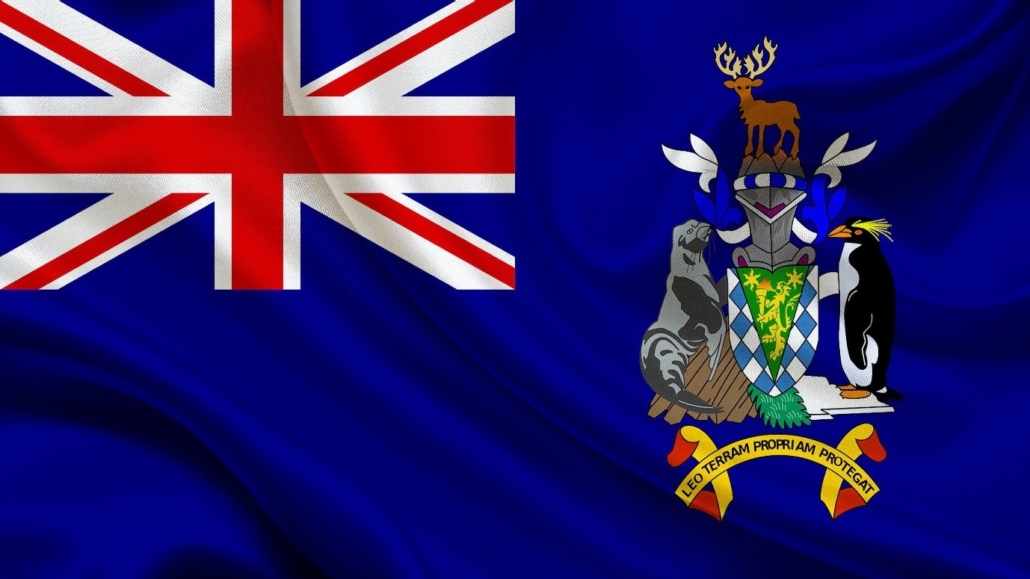
What wildlife will I see?
South Georgia is known as one of, if not the most biodiverse place on Earth. With various types of seals, including around 50% of the world’s Southern elephant seal population. While South Georgia’s noisy, shuffling penguin community comprises four species. Including the world’s largest population of Macaroni Penguins, as well as Gentoo and Chinstrap Penguins, it is the island’s King Penguins that waddle away with much of the spotlight. Lastly, but by no means least there will be wandering albatross with their 3-metre-wide wingspan among various other kinds of birdlife. The potential for numerous whale encounters with five different species routinely spotted around the waters of our expedition among various other marine animals.
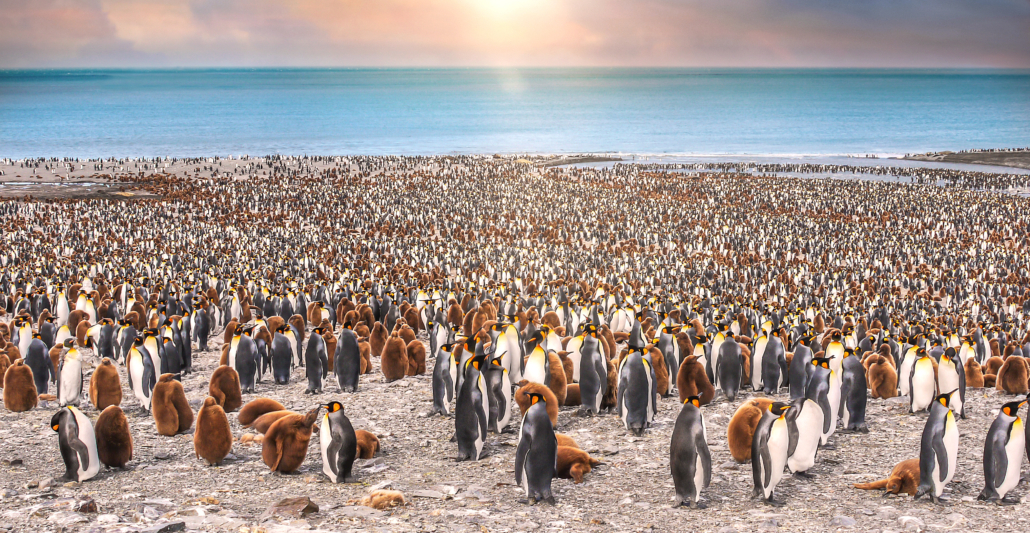
Thousands of adult and juvenile king penguins standing together on beach. Sunlight with bokeh in the sky.
A close up of two king penguins at Grytviken, South Georgia © iStock.com

